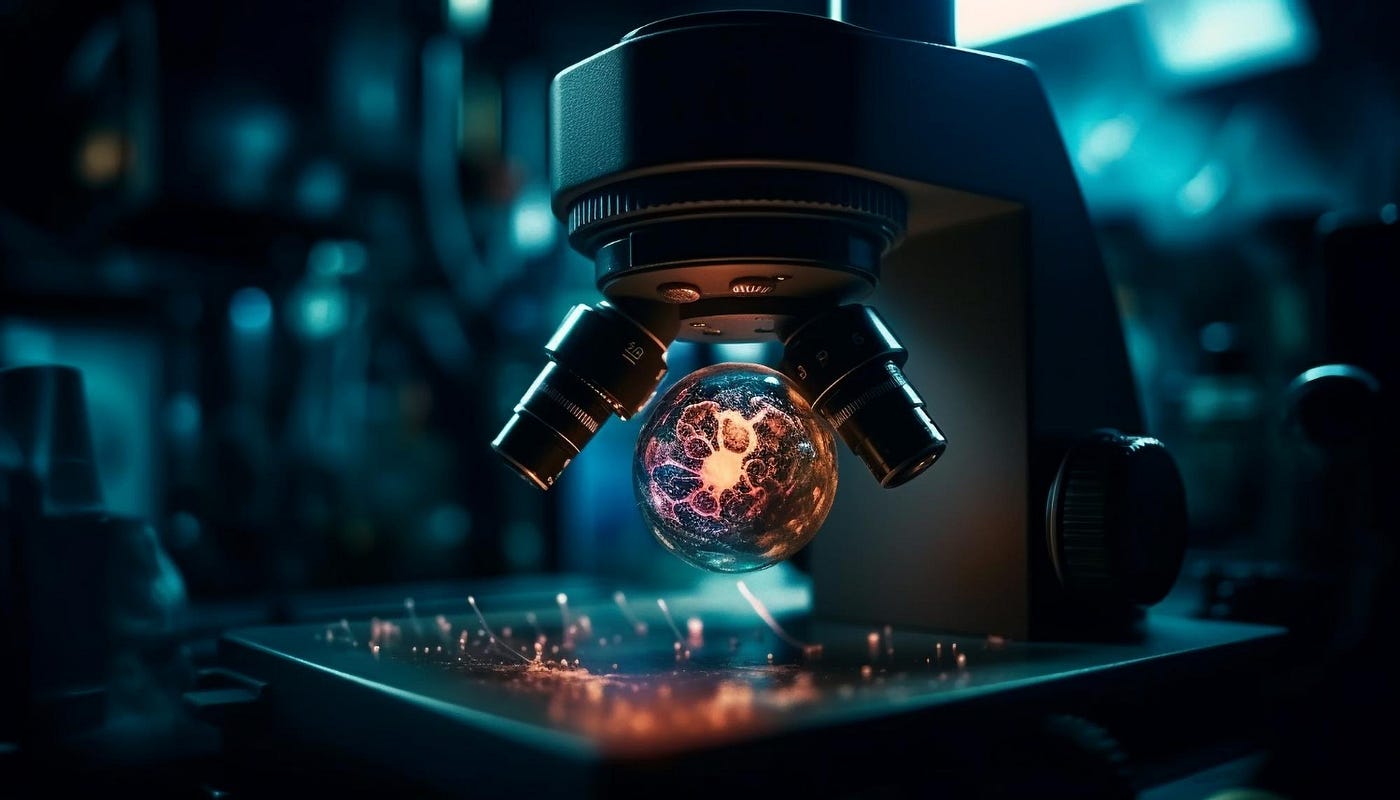Introduction to Future Technology in Healthcare and Medicine
The rapid advancement of technology is reshaping the landscape of healthcare and medicine. From artificial intelligence (AI) to genomics, and robotics, these innovations are not just enhancing patient care but are also redefining the future of medical practices. As we look towards the future, the integration of these technologies promises to bring about a new era of precision, efficiency, and personalized care. Explore how technology is changing healthcare in this deep dive into the future trends.
Artificial Intelligence and Machine Learning

Artificial Intelligence (AI) and Machine Learning (ML) are at the forefront of future technology in healthcare and medicine. These technologies are revolutionizing diagnostics, treatment planning, and even drug discovery, marking a significant shift in how we approach medical challenges.
AI in Diagnostics: Revolutionizing Accuracy
AI-driven diagnostic tools are enhancing the accuracy and speed of disease detection, a key aspect of future technology in healthcare and medicine. For instance, AI systems like IBM Watson and Google’s DeepMind have demonstrated remarkable proficiency in interpreting medical images, often surpassing human experts. Discover more about AI in healthcare and its evolving role in diagnostics as part of the broader scope of future technology in healthcare and medicine.
Predictive Analytics for Early Disease Detection
Predictive analytics, powered by AI, is another pivotal development within the realm of future technology in healthcare and medicine. By analyzing patterns in patient data, these tools enable early detection of diseases such as cancer and heart disease. Explore how AI-driven predictive analytics is shaping the future of healthcare by enabling early interventions.
AI in Drug Discovery and Development
AI is also transforming drug discovery, which is a crucial element of future technology in healthcare and medicine. It significantly reduces the time and cost associated with bringing new drugs to market. Dive into the innovations that AI brings to drug discovery and how it’s reshaping the future of medicine.
Case Study: AI-Driven Breakthrough in Cancer Detection
In a recent study published by Nature, an AI model developed by Google Health demonstrated superior accuracy in detecting breast cancer from mammograms compared to radiologists. This breakthrough showcases how future technology in healthcare and medicine can lead to life-saving advancements, significantly improving cancer screening programs.
Telemedicine and Remote Patient Monitoring
Telemedicine has become a critical component of future technology in healthcare and medicine, especially following the COVID-19 pandemic. It allows patients to access medical care from the comfort of their homes, demonstrating how technology is reshaping healthcare delivery.
The Growth of Telemedicine Post-COVID-19
The pandemic accelerated the adoption of telemedicine, which is now a cornerstone of future technology in healthcare and medicine. Platforms now support a wide range of services, from routine check-ups to specialist consultations, making healthcare more accessible. This shift is not only improving access but also reducing the burden on healthcare facilities.
Advanced Remote Monitoring Technologies
Remote patient monitoring technologies, including wearable devices, are another significant advancement within future technology in healthcare and medicine. These devices continuously monitor vital signs such as heart rate, blood pressure, and glucose levels, transmitting data to healthcare providers in real-time. This ongoing flow of information allows for early detection of potential health issues and timely interventions.
Future Trends in Telemedicine: Beyond Video Consultations
The future of telemedicine is set to extend beyond simple video consultations, which is a testament to the ongoing evolution of future technology in healthcare and medicine. We can anticipate the integration of AI-driven diagnostics, remote robotic surgeries, and even virtual reality (VR) therapies, all aimed at enhancing the quality of care provided remotely.
Case Study: Remote Monitoring in Diabetes Management
A study by the American Diabetes Association highlighted the effectiveness of remote monitoring in managing diabetes, further emphasizing the role of future technology in healthcare and medicine. Patients using continuous glucose monitors (CGMs) showed improved glycemic control and reduced hospital visits, demonstrating the potential of telemedicine in chronic disease management.
By integrating AI, telemedicine, and remote monitoring technologies, the landscape of healthcare is poised for a significant transformation. The advancements in future technology in healthcare and medicine not only promise better patient outcomes but also make healthcare more accessible and efficient globally.
Personalized Medicine and Genomics

Personalized medicine, driven by advancements in genomics, is paving the way for treatments tailored to individual patients. This approach holds promise for more effective therapies with fewer side effects. Learn about the role of genomics in healthcare and how it’s transforming personalized medicine.
The Rise of Genomic Medicine
Genomic medicine involves the use of genetic information to guide medical decisions. By analyzing a patient’s genetic makeup, healthcare providers can identify predispositions to certain diseases and tailor treatments accordingly. Explore the future of genetic editing and its implications for healthcare.
CRISPR and the Future of Genetic Editing
CRISPR technology, a powerful tool for editing genes, has opened new possibilities in treating genetic disorders. CRISPR allows scientists to precisely modify DNA sequences, offering potential cures for conditions that were previously considered untreatable.
Case Study: Genomics in Cancer Treatment
The use of genomics in cancer treatment has led to the development of targeted therapies, such as those for BRCA1 and BRCA2 mutations in breast cancer. Patients with these mutations can receive drugs like PARP inhibitors, which specifically target cancer cells while sparing healthy tissue.
Wearable Technology in Healthcare

The Evolution of Wearable Technology in Future Technology in Healthcare and Medicine
Wearable technology has transformed significantly over the years, evolving from simple fitness trackers to highly advanced medical devices. In the realm of future technology in healthcare and medicine, these wearables are now capable of real-time health monitoring, providing a comprehensive view of an individual’s health status. These devices are playing a pivotal role in preventive care and chronic disease management, making them indispensable tools in modern healthcare. The future technology in healthcare and medicine is increasingly relying on wearable devices to monitor, detect, and even predict health conditions, ultimately improving patient outcomes.
The Impact of Continuous Health Monitoring in Future Technology in Healthcare and Medicine
Continuous health monitoring through wearable devices is a key component of future technology in healthcare and medicine. Devices like smartwatches equipped with ECG monitors and pulse oximeters provide real-time data on vital signs. This continuous monitoring allows for the early detection of potential health issues, enabling proactive management of conditions such as atrial fibrillation or sleep apnea. By integrating wearable technology into everyday life, future technology in healthcare and medicine is ensuring that patients receive timely interventions, reducing the likelihood of complications.
Wearable devices are not just about tracking steps or calories; they are sophisticated tools that collect vast amounts of health data. This data is then analyzed using advanced algorithms, a hallmark of future technology in healthcare and medicine, to detect irregularities that may indicate the onset of a medical condition. For example, an abnormal heart rhythm detected by a smartwatch could prompt a visit to the doctor, potentially preventing a serious cardiac event. This ability to continuously monitor and collect health data makes wearable technology a cornerstone of future technology in healthcare and medicine.
The Role of Wearables in Preventive Care within Future Technology in Healthcare and Medicine
In the context of future technology in healthcare and medicine, wearables are revolutionizing preventive healthcare. These devices can track daily activities, sleep patterns, and other vital health metrics, providing individuals with insights into their overall health. This data can encourage healthier lifestyle choices and prompt users to seek medical advice when necessary. As part of the broader scope of future technology in healthcare and medicine, wearable technology is empowering patients to take control of their health by offering personalized feedback and actionable data.
Preventive care is a crucial aspect of future technology in healthcare and medicine. By catching potential health issues before they become serious, wearable devices can reduce the incidence of chronic diseases. For example, a wearable that tracks blood pressure and alerts the user to high readings can help prevent heart disease. This proactive approach to health management, facilitated by future technology in healthcare and medicine, is making healthcare more efficient and effective.
Case Study: Apple Watch and Its Role in Future Technology in Healthcare and Medicine
One of the most prominent examples of future technology in healthcare and medicine is the Apple Watch and its ECG feature. A study published in The New England Journal of Medicine demonstrated that the Apple Watch could accurately detect atrial fibrillation, a common heart rhythm disorder. This capability highlights the potential of wearable technology in the early detection and prevention of serious health issues.
In this case study, the Apple Watch is a prime example of how future technology in healthcare and medicine is transforming the way we approach health monitoring. By providing users with the tools to monitor their heart rhythm continuously, the Apple Watch enables early diagnosis and treatment, which can be lifesaving. This is just one example of how future technology in healthcare and medicine is making a tangible impact on patient outcomes.
The Future of Wearable Technology in Healthcare and Medicine
As future technology in healthcare and medicine continues to evolve, wearable technology will undoubtedly play an increasingly vital role. From smartwatches that monitor heart health to wearable devices that track glucose levels, the integration of these tools into healthcare systems is transforming how we approach medical care. These advancements in future technology in healthcare and medicine are not only enhancing patient care but are also paving the way for more personalized, data-driven approaches to health management.
Wearable technology is a critical element of future technology in healthcare and medicine, offering continuous monitoring, preventive care, and early detection capabilities that were previously unimaginable. As the technology continues to advance, we can expect even more sophisticated wearables that will further integrate with other future technologies in healthcare and medicine. Whether it’s through AI-driven analytics or real-time data sharing with healthcare providers, wearable technology is set to be a cornerstone of future technology in healthcare and medicine.
Nanotechnology in Medicine

Nanotechnology is another transformative force in future healthcare, offering innovative solutions for drug delivery, diagnostics, and even surgery. Learn more about nanotechnology and its role in the medical field.
Nanomedicine: Tiny Solutions to Big Problems
Nanomedicine involves the use of nanoparticles to deliver drugs directly to diseased cells, minimizing side effects and improving efficacy. This approach is particularly promising in cancer treatment, where targeted drug delivery can significantly enhance the effectiveness of chemotherapy.
The Future of Nanorobots in Surgery and Treatment
The future of nanotechnology in medicine could see the development of nanorobots, tiny machines that can perform precise tasks at the cellular level. These nanorobots could be used for everything from delivering drugs to repairing damaged tissues. Explore the rise of AI-driven nanorobots.
Case Study: Nanoparticles in Cancer Treatment
Research published in the journal ACS Nano demonstrated that nanoparticles could be used to deliver chemotherapy drugs directly to tumor cells in mice. The study showed that this targeted approach reduced tumor size more effectively than traditional chemotherapy, with fewer side effects.
Robotics in Surgery and Rehabilitation
Robotics is revolutionizing surgery and rehabilitation, offering unprecedented precision and improved outcomes. Learn about the latest robotics innovations in healthcare.
The Rise of Robotic-Assisted Surgeries
Robotic systems like the Da Vinci Surgical System are enhancing surgeons’ capabilities, allowing for minimally invasive procedures with greater precision. These systems are particularly valuable in complex surgeries, such as those involving the heart, brain, or prostate. Discover how AI and robotics are reshaping healthcare.
Robotics in Rehabilitation: Enhancing Mobility and Recovery
Robotics is also making significant strides in rehabilitation. Exoskeletons, for instance, are helping patients with spinal cord injuries regain mobility, while robotic arms are assisting stroke survivors in recovering motor functions. Explore AI-driven robotics in rehab.
Case Study: Robotic Surgery in Prostate Cancer
A study published in The Lancet showed that robotic-assisted prostatectomy resulted in fewer complications and faster recovery times compared to traditional open surgery. This highlights the growing importance of robotics in improving surgical outcomes.
3D Printing and Bioprinting
3D printing is making it possible to create custom implants, prosthetics, and even organs, revolutionizing the field of regenerative medicine. Explore the potential of 3D printing in healthcare.
The 3D Printing Revolution in Healthcare
3D printing allows for the creation of patient-specific implants and prosthetics, improving comfort and functionality. In addition, 3D-printed models of organs can help surgeons plan complex procedures with greater precision. Discover the latest trends in 3D printing for healthcare.
Bioprinting: The Future of Organ Transplants
Bioprinting, a subset of 3D printing, involves creating tissue and organ structures using living cells. This technology holds the promise of addressing the shortage of donor organs by enabling the creation of lab-grown organs for transplantation. Learn more about bioprinting in healthcare.
Case Study: 3D-Printed Prosthetics for Amputees
The use of 3D printing has significantly reduced the cost of prosthetics for amputees. Custom-made prosthetics, tailored to the individual’s anatomy, provide better functionality and comfort compared to traditional models.
Virtual and Augmented Reality in Medical Training and Treatment
Virtual reality (VR) and augmented reality (AR) are finding applications in medical training, surgery, and even patient treatment. Explore VR’s impact on healthcare and how it’s enhancing medical practices.
VR in Medical Training: A New Frontier
VR is being used to create immersive training environments for medical students and professionals. These simulations allow trainees to practice procedures in a risk-free environment, improving their skills and confidence. Discover the future of VR in healthcare.
AR in Surgery: Enhancing Precision
AR technology is being used in surgery to provide real-time overlays of patient anatomy, helping surgeons navigate complex procedures with greater precision. Learn more about AR in surgery and its future applications.
Case Study: VR Therapy for Pain Management
A study published in PLOS ONE found that VR therapy could significantly reduce pain levels in patients undergoing treatment for chronic pain conditions. The immersive nature of VR helped distract patients from their pain, providing an alternative to traditional pain management methods.
Conclusion: The Future is Now
The future of healthcare and medicine is being shaped by technological advancements that were once the stuff of science fiction. From AI and robotics to genomics and nanotechnology, these innovations are not only improving patient outcomes but are also making healthcare more accessible, personalized, and efficient. Explore the future of healthcare and the trends that are shaping it.
As we look ahead, it is clear that the integration of these technologies will continue to drive transformative changes in healthcare. However, it is equally important to address the ethical, regulatory, and societal challenges that come with these advancements to ensure that the future of healthcare is not only technologically advanced but also equitable and humane.
FAQs on How Advanced Future Technology in Healthcare and Medicine
What are the most promising future technologies in healthcare?
The most promising future technologies in healthcare include Artificial Intelligence (AI) and Machine Learning (ML), telemedicine, personalized medicine through genomics, wearable technology, nanotechnology, robotics in surgery and rehabilitation, 3D printing, and virtual and augmented reality.
How is AI transforming healthcare and medicine?
AI is revolutionizing healthcare by improving diagnostic accuracy, personalizing treatment plans, predicting patient outcomes, and accelerating drug discovery. AI-driven tools can analyze medical images, predict disease risks, and even suggest optimal treatment strategies.
What role does telemedicine play in the future of healthcare?
Telemedicine is making healthcare more accessible by allowing patients to consult with healthcare providers remotely. It also includes remote patient monitoring, where wearable devices track vital signs and transmit data in real-time, enabling early detection and management of health conditions.
How does personalized medicine through genomics work?
Personalized medicine uses genomic information to tailor treatments to an individual’s genetic profile. This approach can identify genetic predispositions to certain diseases and guide the selection of therapies that are more effective and have fewer side effects.
What advancements are being made with wearable technology in healthcare?
Wearable technology is evolving to provide continuous health monitoring, detecting early signs of diseases, and offering data-driven insights for preventive care. Advanced wearables can monitor heart rate, glucose levels, and even detect abnormal health patterns, prompting timely medical interventions.
What is the future of robotics in surgery and rehabilitation?
Robotics is set to enhance precision in surgeries and aid in rehabilitation by providing tools that improve patient outcomes. Robotic-assisted surgeries offer minimally invasive options, while rehabilitation robots help patients regain mobility and function after injuries or surgeries.







